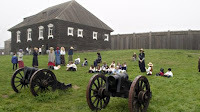So might an 1812 newspaper have declared when it was finally discovered that ninety-five Russians along with forty-five native Alaskans (Aleuts and Kodiak Islanders) had sailed their ship, the Chirikov into a cove along the rugged northern California coast, boldly coming ashore where there was good farm land and fresh water.
There had been no one to stop them. Nearly half a century earlier, in 1769, the Russians presence in the Pacific Northwest had prodded the Spaniards into occupying Alta California. But on that day in 1812, their northernmost Spanish settlement was at San Francisco Bay, many miles south.
France, Great Britain, and Russia--along with the other major powers of the time--were involved in a European War. Napoleon's army was in the heart of Russia, headed toward Moscow and England was at war with a small but rebellious colony which had broken away and named itself The United States of America.
During the summer that the fort was built, the world had been so engrossed in their own immediate problems they had neither known nor guessed Russia's plans for further colonization. And so, what had begun nearly 250 years earlier, under the reign of Russia's first Tsar, Ivan-The-Terrible, continued: eastward expansion.
 |
| The California sea otter was long thought to be extinct due to over hunting. In 1938 a small colony was spotted at the mouth of Bixby Creek Bridge on the Big Sur Coast. |
 |
| 1838 sketch of the Fort Rossiya settlement. |
 |
| Living history in July, visitors more than welcome. |
 |
| The fort's Russian Orthodox Chapel was built in 1825. It was destroyed by fire in 1970 and has since been completely rebuilt. |
In December of 1841, after failing to sell Rossiya to the Mexican government as well as others they had approached, the Russians made an agreement with John Sutter from Sutter's Fort in the Sacramento Valley. Within a few short months of selling Rossiya, the Russians had packed up their belongings, boarded their ship, the Constantine, and sailed away. They disappeared from our shores--along with the sea otter they had so mercilessly hunted.
 |
| View across the compound to the eight-sided blockhouse. |
The three sally-ports stand open now. On a clear day the view from the openings is worth the short walk from the visitor parking lot to the old fort site. The giant bell hanging outside the chapel is a child's delight, just made for ringing. Its clear, low tone reverberates throughout the compound and across the countryside. The new Commandant's House with its rough-hewn timber floor and walls smell of dust and times-past. It now houses the Visitor Center and a small gift shop.
Walk through the buildings and about the grounds. Touch everything. There are few ropes here to keep the curious out. Climb the narrow stairs of the two blockhouses, touch the canons still guarding their windows. Examine the exhibits. Enjoy the view. Fort Ross, as it is now called, is a State Historic Park and as such is under the jurisdiction of California's Department of Parks and Recreation. It lies just north of San Francisco. It is a remnant of our historic past when the Russians landed, but did not stay. What they left us is a one-of-a-kind: America's only Russian fort.
Author's note:
The first time we visited Fort Ross was during the late 1950s when the fort lay right alongside The Old Coast Highway and was so intriguing, it demanded we stop. Our kids loved exploring the buildings, climbing into the blockhouses, and ringing the church bell. The next time we went back more of the buildings had been reconstructed and plans were in the making for eventually restoring the fort to its original state. This is a place your family will love--especially your children.

No comments:
Post a Comment